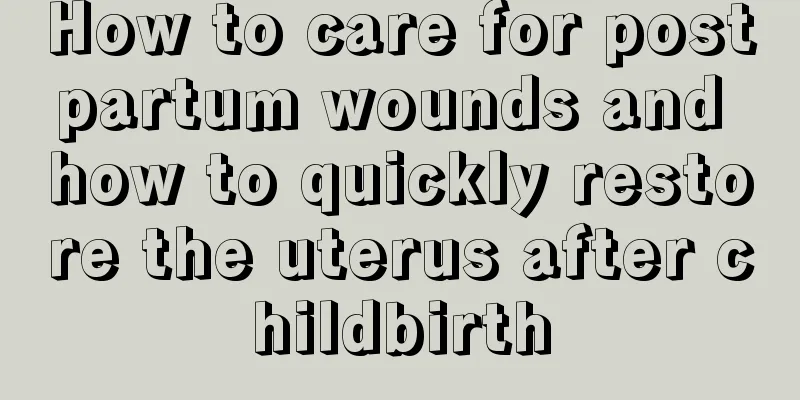How to care for postpartum wounds and how to quickly restore the uterus after childbirth

|
Women's figures and bodies will change after giving birth. Many people choose cesarean sections. The wounds from cesarean sections are relatively large and need to be well cared for. Usually, the amount of activity should be reduced to promote wound healing. So how to care for postpartum wounds? Methods for rapid recovery of the uterus after childbirth. How to care for wounds after childbirthPostpartum wound care for vaginal delivery 1. Keep the vulva clean. Use 10% Jie'eryin liquid to wash the vulva from the second day of delivery, or use 10% Jie'eryin to scrub the vulva twice a day until the stitches are removed. If you feel swelling or pain in the vulva wound, seek medical attention immediately. Generally, you can use 95% alcohol gauze wet compress or 50% magnesium sulfate hot compress. 2. Keep bowel movements smooth and flush the vulva and anus after defecation. Change sanitary pads and underwear frequently. 3. When sleeping or lying in bed, it is best to lie on the side without the perineal wound to reduce the chance of lochia flowing into the perineal wound. Postpartum wound care after cesarean section Because the wound caused by cesarean section is large, it takes about 4-6 weeks to fully recover. 1. New mothers should take more walks after surgery. Walking can help new mothers restore gastrointestinal system function as soon as possible. 2. Check the abdominal incision every day and disinfect the wound. Again, measure the body temperature twice a day within 1 week after the operation (if the new mother feels unwell, the temperature should be measured more frequently). 3. Finally, within two weeks after the operation, avoid getting the abdominal incision wet. New mothers can use a wet towel to bathe, and must not take a tub bath until the lochia is completely discharged. Methods for rapid recovery of the uterus after childbirth1. Don’t hold your urine After giving birth, new mothers will have problems such as bladder pressure, mucosal congestion, decreased muscle tension, and pain in the perineal wound. In addition, they are not used to urinating in bed, which makes them more likely to have urinary retention, causing the bladder to expand and hindering uterine contraction. Therefore, the first thing to do after giving birth is to urinate in a timely manner. 2. Massage the uterus After giving birth, when the new mother's physical strength has recovered to a certain extent, she should generally perform uterine massage on the next day. Place your hands around the navel and do clockwise circular massage to help and promote uterine contraction. 3. Massage breasts and stimulate nipples After giving birth, the mother should let the baby suck breast milk as soon as possible. This is not only conducive to the delivery of breast milk, but also can stimulate uterine contraction. The physiological principle of uterine contraction is that when the nipple is stimulated, the body will also produce uterine contraction hormone, so no matter what physical method is used to stimulate the breasts, the uterus can contract. 4. Avoid abdominal fatigue Postpartum mothers must pay attention to rest and not overwork, and pay attention to keeping the abdomen warm. They can do some postpartum exercises, such as deep abdominal breathing, and lying on a hard bed one week after delivery to lift their legs and hips, or do knee-chest lying exercises, which can effectively contract and recover the uterus and lower abdomen. 5. Take Shenghua Tang for conditioning Shenghua Tang is more suitable for taking during the postpartum period. It has a significant effect on helping the uterus recover. It can help the mother to remove blood stasis and replenish blood. When the lochia is eliminated, the uterus will naturally contract. 6. Do pelvic floor exercises early The main purpose of the anal lifting exercise is to contract the anus. After each anal lifting, you should hold it for 20-30 seconds and then relax. Do this 3-5 times in each set. This powerful "muscle contraction" movement can slowly restore the originally enlarged uterus to its original size. What to do if the wound becomes inflamed after childbirthIf the wound of a normal delivery is inflamed, swollen, painful, or hardened, follow the doctor's advice to take antibiotics and soak the wound in warm water with 1:5000 potassium permanganate twice a day for 10-15 minutes each time. You can also use Chinese medicine (ask a Chinese medicine doctor to prescribe medicine) to wash the wound, which is also very effective. If conditions permit, you can use a desk lamp at home for local physical therapy, but be careful not to burn yourself. The treatment of wound inflammation after cesarean section depends on the wound condition. If the wound inflammation is small, oral antibiotics can be considered. If the wound inflammation is large, oral antibiotics must be considered, and wound expansion surgery, frequent dressing changes, and subsequent wound re-suturing surgery must be performed. Types of postpartum woundsWomen have two options when giving birth, natural birth or cesarean section, and the wounds caused by the two delivery methods are different. 1. Wounds left by natural childbirth There are generally two types of wounds left by natural childbirth. One is some minor injuries caused by the collision of the baby's head or the presenting part with the vaginal tissue during natural childbirth. The wound is small and sometimes a small stitch may be needed to stop bleeding. It heals on its own after delivery and does not require special care. The other is vaginal laceration, which is larger and deeper. Clinically, it is often called first, second, or third degree laceration due to the size of the laceration and the damaged tissue. It is also a wound left by episiotomy. It is more serious and prone to infection and needs good care. 2. Wounds left by caesarean section After all, cesarean section is to make a new incision in the abdomen. Generally, there are several types of procedures, such as longitudinal incision, transverse incision, and extraperitoneal incision. Modern cesarean section generally adopts transverse incision in the lower abdomen, which is relatively less damaging and leaves a good-looking scar. Regardless of the procedure, seven layers must be cut and seven layers must be sutured. Only when the layers are aligned and neat can the wound heal well. |
Recommend
What services are included in a doula delivery? Does a doula delivery require an episiotomy?
Before giving birth, many mothers heard that the ...
How to choose a pillow to help your baby sleep better? Choose from these 4 points
Babies in their infancy need more sleep to mainta...
What does painless childbirth mean? Is painless childbirth better than normal childbirth?
Many people cannot stand the pain during childbir...
What are the symptoms of dystocia?
Dystocia is a situation that every pregnant frien...
How much does folic acid cost? Which brand of folic acid is better?
Pregnant women need to supplement folic acid in t...
Should baby food be added with oil? What kind of oil should be added to baby food?
As babies grow older, mothers need to start addin...
Can Kao steam eye mask be used by children? What age is Kao steam eye mask suitable for?
Steam eye masks can prevent myopia and relieve ey...
2017 Kindergarten Outdoor Activities Lesson Plan 2017 Kindergarten Sports Meeting Plan
2017 Kindergarten Outdoor Activities Lesson Plan ...
Can eating eggs improve intelligence?
Eggs are rich in nutrients and are very suitable ...
Can children with coughs be vaccinated? Can children with coughs be given milk?
Children are prone to getting sick easily because...
Which country's brand is Ariel laundry detergent from? How to tell whether Ariel laundry detergent is real or fake?
The Ariel brand has a long history. Have you ever...
How to choose the size of nursing bra? The most reliable store to buy
It is difficult to choose the size of nursing bra...
Postpartum mothers tell their own stories: How painful is natural childbirth?
Most mothers choose to give birth naturally, but ...
What should I do if I have corpus luteum deficiency? How can I treat corpus luteum deficiency with diet?
Corpus luteum deficiency refers to insufficient s...
Is Yunnan Baiyao toothpaste suitable for long-term use? Can Yunnan Baiyao toothpaste be used by children?
Yunnan Baiyao toothpaste can not only be used to ...









